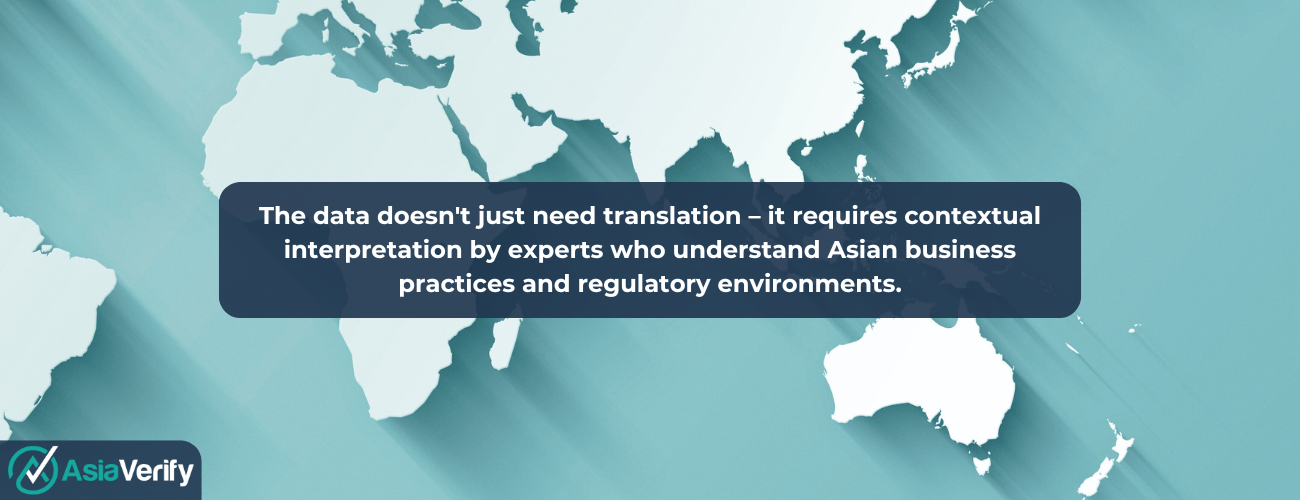By Jacqueline Fleming, Head of Growth at AsiaVerify.
The Dangerous Void in Your Supply Chain Intelligence
If you’ve ever stood on a London Underground platform, you’ve heard the iconic warning: “Mind the gap.” It’s a simple phrase with life-saving implications, as that small space between train and platform edge represents real danger for the non-observant traveler.
Today’s global business landscape demands a similar warning for companies conducting supplier and merchant third-party due diligence. Whether you have long-standing operations across the region or are expanding growth with new partners; Mind the Gap in your Asian data.
When your due diligence reports are incomplete – missing critical information from China and other Asian jurisdictions, you’re not just missing a piece of the puzzle. This gap could expose your business to material risk with regulatory penalties, reputational damage, and supply chain catastrophes waiting below.
The Manufacturing Epicenter You Can’t Afford to Ignore
Asia, particularly China, remains the undisputed manufacturing powerhouse of the global economy. Consider these staggering realities:
- China alone accounts for nearly 30% of global manufacturing output – more than the United States, Japan, and Germany combined.
- The ASEAN region has emerged as the world’s fastest-growing manufacturing hub, with Vietnam, Thailand, Malaysia, and Indonesia capturing increasing market share.
- Even with recent diversification trends, approximately 70-80% of global consumer electronics supply chains have at least one critical component originating from Asia.
This manufacturing dominance means that virtually every complex product in your home or office has touched Asian soil at some point in its journey – whether in raw material extraction, component manufacturing, assembly, or distribution. For global businesses, this creates an unavoidable reality: you cannot conduct meaningful due diligence without robust Asian data coverage.
The Hole in Your Due Diligence Process
Picture this: Your team has meticulously gathered data on a potential supplier. You’ve checked credit ratings, criminal records, financial stability, and regulatory compliance. The report looks immaculate – except for that conspicuous void where Chinese and Asian data should be.
This isn’t just an information gap – it’s a risk multiplier.
Why? Because in today’s interconnected global economy, Asian connections lurk within virtually every extended supply chain. That seemingly European or American company you’re vetting likely has tier-two or tier-three suppliers across Asia that remain invisible without proper intelligence.
The complexity runs deeper than most people realize. A single “finished product” supplier might be integrating components from dozens of sub-suppliers across multiple Asian countries – each with their own risk profile, regulatory challenges, and hidden connections.
The Complexity of Asian Business Ecosystems
What makes Asian due diligence particularly challenging is the nature of business structures and practices that don’t neatly align with Western frameworks:
The China Challenge
- Diverse Business Structures: From State-Owned Enterprises (SOEs) to private companies with state connections, joint ventures, and complex holding companies, the Chinese corporate landscape defies simple categorization.
- Data Fragmentation: Critical business information is scattered across provincial administrations, industry-specific databases, and various regulatory bodies – requiring specialized knowledge to navigate.
- Name Variations: A single Asian entity might appear under multiple transliterations or trade names across different documents and jurisdictions, making simple name-matching ineffective.
- Beneficial Ownership Opacity: Determining true control often requires untangling complex webs of nominees, offshore structures, and family connections that aren’t apparent in official registrations.
- Jurisdictional Diversity: Each of the 48+ countries across Asia maintains unique corporate registration systems, regulatory frameworks, and compliance requirements.
- Language Barriers: Documentation spans dozens of languages from Mandarin, Japanese, Korean, and Thai to Vietnamese, Bahasa Indonesia, and many more – each with their own nuances that machine translation often misses.
- Informal Networks: Especially in Southeast Asia, crucial business relationships and control mechanisms may exist through familial connections or cultural obligations that don’t appear in any formal documentation.
- Varying Transparency Levels: Information accessibility ranges dramatically – from Singapore’s relatively transparent systems to the opaque environments of Myanmar or Laos.
This extraordinary complexity means that standard due diligence processes most of us are familiar with simply fail when applied to Asia. The data doesn’t just need translation – it requires contextual interpretation by experts who understand local business practices and regulatory environments.
The Regulatory Train has left the Station – and Fast
The regulatory landscape has transformed dramatically. Recent legislation and reciprocal tariffs make comprehensive due diligence not just advisable but mandatory:
- The Uyghur Forced Labor Prevention Act (UFLPA) creates a presumptive ban on imports from China’s Xinjiang region, requiring “clear and convincing evidence” that goods are made without forced labor – evidence impossible to produce without thorough Chinese due diligence.
- The EU’s Corporate Sustainability Due Diligence Directive (CSDDD) demands rigorous assessments of environmental and human rights impacts throughout entire supply chains, with civil liability provisions for non-compliance.
- Germany’s Supply Chain Due Diligence Act, France’s Corporate Duty of Vigilance Law, and Japan’s Guidelines on Corporate Human Rights Due Diligence all set stringent standards requiring complete supply chain visibility.
Reciprocal tariffs add another layer of compliance complexity, by recalibrating trade costs and mandating rigorous financial due diligence processes. They require companies to meticulously document cost inputs and cross-border pricing adjustments, ensuring that every facet of the supply chain is examined with the same exacting standards as environmental and human rights impacts. We’ll come back to that in a moment.
The consequences are no longer just reputational. One major electronics manufacturer faced a seven-figure penalty from the Office of Foreign Assets Control (OFAC) for failing to conduct “full spectrum” supply chain due diligence, despite self-disclosing the violations. As OFAC noted, the company had invested substantially in quality control but not in regulatory compliance across its international operations.
Companies caught with incomplete due diligence now face not just fines but potential import bans, effectively shuttering vital supply pipelines overnight.
The Tariff Twist: Why NOW Is the Critical Moment
The urgency couldn’t be higher. We’ve entered an unprecedented era of trade volatility, with tariffs reshaping global supply chains at breathtaking speed.
Recent data reveals the immediate impact of new tariffs between the U.S. and Asia:
- Shipments from China to the U.S. have plummeted by 60% since early April 2025, according to supply chain management firm Flexport.
- Container bookings from China to the U.S. have dropped sharply, while bookings from Vietnam and Thailand have increased by 5-10% as companies scramble to diversify production.
- Major retailers report that the 145% tariffs have made Chinese goods roughly 2.5 times more expensive than last year.
This tariff war has triggered what industry experts call “the greatest supply chain restructuring since globalization began.” Companies are frantically reconfiguring supplier networks, with production shifting to Vietnam, Thailand, Malaysia, Indonesia, and India – countries with their own complex regulatory environments and opaque business structures.
But here’s the critical insight many miss: These rapid supplier shifts dramatically increase exposure to unknown risks.
As companies rush to secure new suppliers, proper due diligence often takes a backseat to speed and operational continuity – there simply isn’t time to recalibrate third-party due diligence providers and workflows. Without immediate access to a comprehensive Asian data, you’re flying blind during the most dangerous navigational challenge in recent business history.
The Hidden Connections You Can’t Afford to Miss
Even as companies diversify operations across Asia, the Chinese presence remains. Consider these scenarios that comprehensive Asian data could reveal:
- Proxy Operations: A seemingly Indonesian supplier that’s actually a shell company for a Chinese operation attempting to circumvent tariffs. These sophisticated structures often involve nominee directors, complex holding company arrangements, and deliberately obscured funding sources.
- Ultimate Beneficial Ownership: A Vietnamese manufacturer that appears independent but is secretly controlled by Chinese interests under sanctions. Recent investigations have uncovered numerous cases where sanctioned Chinese entities maintain de facto control through complex offshore structures or undisclosed “silent partner” arrangements.
- Component Sourcing: A Thai supplier whose components still originate from high-risk Chinese regions, exposing you to UFLPA violations. Without supply chain mapping that can trace materials to their origin, companies remain vulnerable to “origin laundering” where high-risk inputs are obscured through intermediaries.
- Financial Entanglements: A Malaysian partner with substantial Chinese debt or dependency on Chinese technology licensing, creating vulnerability to sudden supply disruption. These financial dependencies often remain invisible in standard credit checks but represent critical stability risks.
- Regulatory Red Flags: A Singaporean distributor with an impeccable local reputation but a history of environmental violations in their Indonesian manufacturing facilities or labor abuses in their Cambodian operations – issues that would never appear in standard due diligence limited to a single jurisdiction.
- Sanctions Evasion Networks: A seemingly compliant trading company using sophisticated transshipment routes through multiple Asian jurisdictions to disguise connections to sanctioned entities – a practice that has grown increasingly sophisticated as sanctions regimes have tightened.
Without Asian data integration, these critical risk factors remain invisible until they erupt into crisis, by which point the damage to your operations, reputation, and compliance status may be irreparable.
The Real-World Impact of Complete Due Diligence
Complete due diligence isn’t just about compliance – it’s about competitive advantage. Companies with comprehensive visibility can navigate supply chain disruptions with confidence while competitors stumble in the dark.
The solution? Fill the Asia data gap with purpose-built intelligence that provides:
- Entity verification across Asian languages and jurisdictions, with capabilities for matching entities across multiple transliterations and trade names.
- UBO mapping revealing complex ownership structures through both official records and sophisticated network analysis.
- Regulatory compliance screening against Asian sanctions and watchlists, including provincial and industry-specific regulatory actions.
- Litigation history from jurisdictions often excluded from Western databases, revealing disputes that could impact operational stability.
- Media screening in local languages to capture reputational red flags, including environmental violations, labor disputes, and community conflicts.
- Supply chain mapping that extends beyond tier-one suppliers to identify critical dependencies and hidden risks in extended networks.
In today’s volatile landscape, complete due diligence isn’t a luxury – it’s survival gear, and a fundamental principle of modern risk management. Remember: In due diligence, what you don’t know can absolutely hurt you. Mind the gap.
Bridge the Gap: Get Verified Asian Business Data
Gain confidence in your due diligence process with AsiaVerify’s real-time access to official Asian business data. Start verifying with certainty today.







